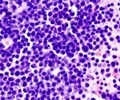A cure for multiple myeloma has not yet been discovered. Currently,its diagnosis means, high-dose chemotherapy followed by repeated treatments with each relapse of the cancer – a watch and wait approach. Recently, a team of international researchers from France, Switzerland, and Belgium explored the possibility of providing patients with continuous therapy to keep the cancer at bay.Their findings will be published in the November 15, 2006, issue of Blood, the official journal of the American Society of Hematology.
'We have been anxiously waiting for the results of this study in the multiple myeloma community, as the issue of maintenance therapy has never been resolved,' said Joseph Mikhael, MD, a hematologist at the Princess Margaret Hospital in Toronto. 'The results are impressive in favor of ongoing treatment of patients with multiple myeloma, and are quite likely going to change the standard of care.'In multiple myeloma, an overgrowth of abnormal cells in the bone marrow leads to the painful destruction of bone. In this study, pamidronate, a drug often used early in the treatment of multiple myeloma to help protect against bone damage, was for the first time studied as a maintenance therapy. Its use alone was compared against its combination with, thalidomide, a drug known to inhibit the growth of myeloma cells. A third set of patients in the study did not receive any maintenance therapy, the current standard of care in this disease.
A total of 597 patients participated, and measures of success included the likelihood of the cancer coming back, the risk of an adverse skeletal event (such as a bone lesion), and the patients' overall survival probability. The findings are listed below
(a)The results of using pamidronate alone compared with going without maintenance therapy were similar. The three-year probability of the patients remaining relapse-free was 38 percent without maintenance therapy and only somewhat better – at 39 percent – with pamidronate alone. The addition of thalidomide significantly improved these odds to 51 percent.
(b)The use of pamidronate did not decrease the number of bone events as anticipated, and there was no significant difference in the number of these events between the three treatment groups.
(c)The chance of overall survival four years after study enrollment in the pamidronate-thalidomide group was 87 percent. Patients in the pamidronate-alone arm had a 74 percent survival probability compared with those not receiving therapy at 77 percent. Thalidomide, however, is not for everyone. The drug was originally dosed at 400 mg per day, but after 15 months, the median dose was decreased by half because of drug-related toxicity. Thalidomide was discontinued in 39 percent of the patients due to side effects such as numbness, tingling, or pain in the hands and feet, fatigue, and constipation. In contrast, only 4 percent of patients discontinued pamidronate.
Advertisement
'Thalidomide shows great promise for keeping multiple myeloma in check after chemotherapy,' said Michael Attal, MD, PRD, lead author of the study and Head of the Department of Hematology at Hôpital Purpan in Toulouse, France. 'If measures can be taken to mediate the toxicity of the drug, or if only those who would get the most benefit from it are treated, this could be an effective long-term therapy for many patients.'
Advertisement
ASH










